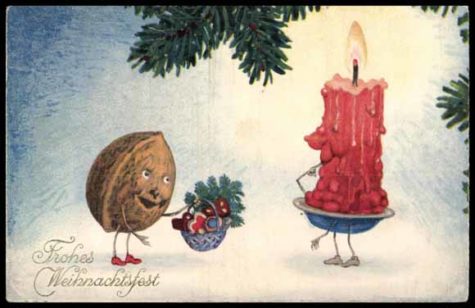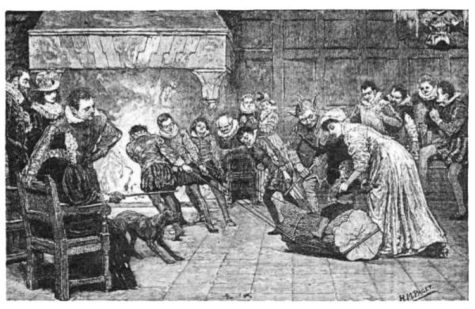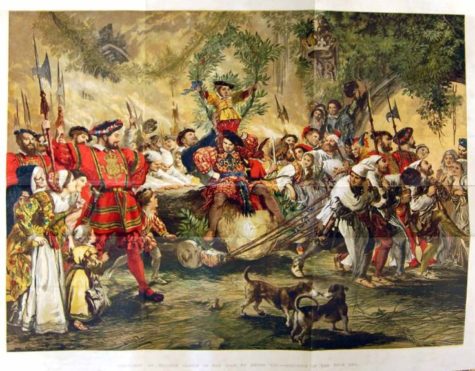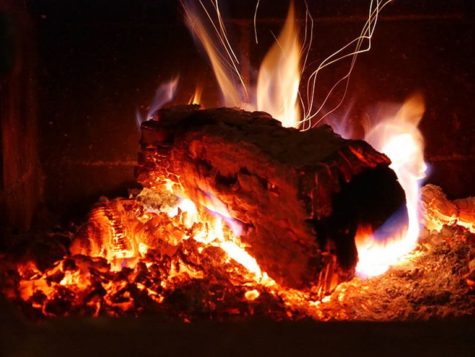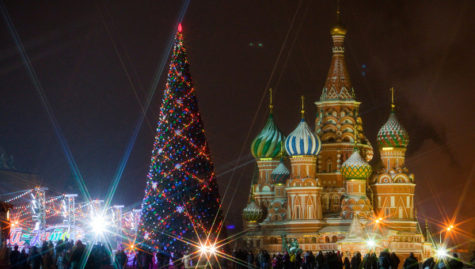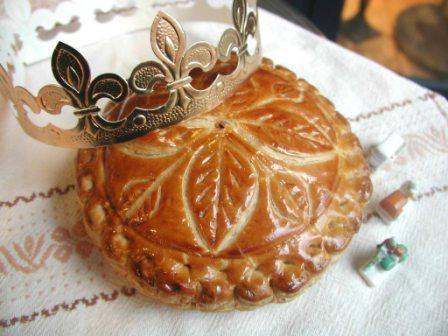Christmas Celebrations
The sending of cards is a fairly modern tradition, and used to be only for people that you would not be actually seeing. It was considered polite to give your greetings in person, whenever you could. However, today clever marketing from the manufacturers means that we tend to send cards to everyone, even when they live in the same house.
Whether you celebrate Yule, Christmas or another festival in December, you will probably be sending greeting cards. If you do this now then not only do you save a panic later, but also you will have the time to do a bit more than just scrawl your name. For those people with whom you are not in regular contact, try writing a few lines telling them what’s happening in your world at present. You could also enclose a small token, perhaps a pressed flower, to bring them cheer. Of course if you have the time it can be nice to make your own cards, and there are kits which can be bought to help with this.
For special people make your card into a spell for them. Decorate it with flowers or other plants which will bring them good fortune, like Fern, Oak, Holly, Poppy, Rose petals, or Violet. Alternatively, select plants for harmony, like Lavender, Passion Flower and Gardenia.
So get out your address book, dust off your memory and write your cards, now, before the festive season gets fully under way. You’ll thank yourself for it later! And don’t forget to have a few cards over, just in case there’s someone you forget.
From: The Real Witches’ Year
Wassailing means “to wish health to” one’s apple trees, in the hope that they will bear well. In addition, drums, bells, whistles etc. were used either to scare off evil spirits, or to wake the tree up; a libation of cider or ale was poured over the roots, and bread that had soaked in the ‘wassailing’ bowl was placed in the branches – an offering back to the tree.
Note:
Recipes for wassail are numerous and varied. Some call for the use of apple cider, some for wine. The basic idea is that you are making a hot spiced drink and serving it in a bowl amidst love and laughter. Here is a simple recipe that calls for cranberry and orange juice. Feel free to experiment and substitute.
Ingredients:
- 4 cups cranberry juice
- 1/2 cup grenadine
- 2 cups orange juice
- 1/2 cup rum (optional)
- Sugar or honey – to taste
Directions:
Put everything into a large soup or stock pot and bring to a low simmer. If you added honey or sugar, mix gently until it dissolves. Lower the heat and very low simmer the mixture for 2 hours before serving. Keep it on low or use a crockpot on low if serving over hours. The longer you heat, the more infused the flavors will be.
Orange slices or orange wedges studded with cloves, cinnamon sticks, and cranberries can be floated in the pot and simmered along with the rest of the ingredients.
When you are ready to serve your Christmas Wassail, just ladle into your favorite mug and enjoy. This delicious and warm drink is a holiday treat! Garnish with a cinnamon stick if you like.
Source: Earthwitchery
Figgy pudding is a pudding resembling something like a white Christmas pudding containing figs. The pudding may be baked, steamed in the oven, boiled or fried. The history of figgy pudding dates back to 16th century England. Its possible ancestors include savory puddings such as crustades, fygeye or figge (a potage of mashed figs thickened with bread), creme boiled (a kind of stirred custard), and sippets. In any case, its methods and ingredients appear in diverse older recipes.
Today, the term figgy pudding is popularized mainly by the Christmas carol “We Wish You A Merry Christmas,” which includes the line, “Now bring us some figgy pudding” in the chorus.
And here it is (from Food.com) a recipe for Figgy Pudding. This is not a traditional pudding, it’s actually more bread or cake-like. The taste may be a little strange to some, but it smells and tastes like Christmas. The figgy pudding should always be served warm. If you can’t serve it fresh out of the oven, it will taste just fine to warm it in the microwave for a few seconds.
Ingredients:
- 16 ounces dried figs
- 1 3/4 cups milk
- 1 1/2 cups all-purpose flour
- 1 cup sugar
- 2 1/2 teaspoons baking powder
- 1 teaspoon ground nutmeg
- 1 teaspoon ground cinnamon
- 1 teaspoon salt
- 3 eggs
- 1/2 cup melted butter
- 1 1/2 cups breadcrumbs
- 1 tablespoon grated orange peel
Directions:
Preheat oven to 350 degrees F. In a a medium saucepan, heat milk and chopped figs over medium-low heat but do NOT bring to a boil. Cook for 10-15 minutes stirring occasionally. The the milk will soften the figs.
In a medium bowl mix flour, sugar, baking powder, nutmeg, cinnamon, and salt. In a large bowl, beat eggs one minute on high. Reduce speed to low and add butter, bread crumbs, orange peel, and warm fig mixture. Slowly incorporate flour mixture. Beat until just blended.
Pour the mix into the greased bundt pan. Level top as much as possible. Cover the mold with a piece of aluminum foil greased on one side, greased side down. Place the mold in a roasting pan and place on oven rack. fill with hot tap water 2 inches up the side of the mold. Bake for 2 hours or until the pudding is firm and it is pulling away from the side of the bundt pan.
Remove the pudding from the water bath. Remove the foil and cool on a wire rack for 10 minutes before unmolding. Invert bundt pan onto a serving plate and remove mold. It should come away easily.
Serve with a hard sauce.
Yes you can have a family Yule celebration and still have a holiday tree, and hang stockings with care by the fire.
During the Roman festival of Saturnalia, celebrants often decorated their homes with clippings of shrubs, and hung metal ornaments outside on trees. Typically, the ornaments represented a god — either Saturn, or the family’s patron deity. The laurel wreath was a popular decoration as well. The ancient Egyptians didn’t have evergreen trees, but they had palms — and the palm tree was the symbol of resurrection and rebirth. They often brought the fronds into their homes during the time of the winter solstice.
Early Germanic tribes decorated trees with fruit and candles in honour of Odin for the solstice. These are the folks who brought us the words Yule and wassail, as well as the tradition of the Yule Log!
In other words, if you want to have a decorated tree for the holiday, don’t let anyone tell you it doesn’t have Pagan origins. And if you’d like to go for a more authentic pagan look, there are a ton of other things out there you can use.
Here are some ideas:
- Suns and solar ornaments – raid the craft stores and find stars to turn into suns
- Gods Eyes – make then out of cinnamon sticks and seasonal coloured yarn or ribbons
- Pentacles – make them out of shiny chenille stems, bent into stars with circles around them
- Natural objects like acorns, feathers, holly, mistletoe or pine cones
- Lights, lights, and more lights
- Magical items – cups, wands, or daggers
- Fertility symbols – eggs, antlers, horns
On the winter solstice, on the longest night of the year, people would place and set afire an entire tree, that was carefully chosen and brought into the house with great ceremony. The largest end of the log would be placed into the fire hearth while the rest of the tree stuck out into the room! The log would be lit from the remains of the previous year’s log which had been carefully stored away and slowly fed into the fire through the Twelve Days of Christmas.
It was considered important that the re-lighting process was carried out by someone with clean hands.
Tradition has it that the burning of the Yule log was performed to honor the Great Mother Goddess. The log would be lit on the eve of the solstice using the remains of the log from the previous year and would be burned for twelve hours for good luck and protection.
As the fire began all other lights would be extinguished and the people would gather round the fire. In thanksgiving and appreciation for the events of the past year and in bidding the year farewell each person would toss dried holly twigs into the fire.
The next phase of the burning of the Yule log commenced with people tossing oak twigs and acorns into the fire and they would shout out their hopes and resolutions for the coming New Year and sing Yuletide carols. The celebration of the Yule log fire ended with unburned pieces of the Yule log saved to start the fire of next winter’s solstice Yule log.
The custom of the Yule Log spread all over Europe and different kids of wood are used in different countries. In England, Oak is traditional. The “mighty oak” was the most sacred tree of Europe, representing the waxing sun, symbolized endurance, strength, protection, and good luck to people in the coming year. In Scotland, it is Birch; while in France, it’s Cherry. Also, in France, the log is sprinkled with wine, before it is burnt, so that it smells nice when it is lit.
The earliest Yule Log in France can be traced back to Celtic Brittany. When the Catholic Church stamped out the Pagan tradition, it adapted. In the 12th century, the ceremony became more elaborate.
Families would haul home enormous logs and in some regions, the youngest child was allowed to ride the log home. As families dragged their logs home, passers by would raise their hats because they knew the log was full of good promises and its flame would burn out old wrongs.
For the Vikings, the yule log was an integral part of their celebration of the solstice, the julfest; on the log, they would carve runes representing unwanted traits (such as ill fortune or poor honor) that they wanted the gods to take from them.
People would also use the log as a way to predict events in the upcoming year. They would hit the burning log with tongs and the embers emitted would tell them what the harvest would be like. The more embers, the more corn. The fire was read and predictions were made for the coming year based on the sparks and flames they saw, like how many chickens or calves would be born, marriages in the family, health, wealth, etc. If the fire cast shadows on the wall, there would be a death in the family that year.
The remaining cinders would be placed in the soil so they would prevent grain diseases and produce a good harvest. They’d be spread around chicken coops to keep away foxes and in the barns and lofts where corn was stored to keep rats and weevils away. During a storm, throwing a handful into the fire would keep the house safe from lightening.
The ashes of the Yule Log were believed to hold magical and medicinal powers that would ward off evil spirits for the coming year. Ashes from the Yule log are very beneficial to garden plants, however, it is considered very unlucky to throw out the ashes of the Yule log on Christmas day.
Various chemicals can be sprinkled on the log like wine to make the log burn with different colored flames! Here’s a short list. Be sure to follow safety precautions if you plan on using them!!
- Potassium Nitrate = Violet
- Barium Nitrate = Apple Green
- Borax = Vivid Green
- Copper Sulphate = Blue
- Table Salt = Bright Yellow
Christmas in Russia is celebrated on 7 January and marks the birthday of Jesus Christ. Christmas is mainly a religious event in Russia. On Christmas Eve (6 January), there are several long services, including the Royal Hours and Vespers combined with the Divine Liturgy. The family will then return home for the traditional Christmas Eve “Holy Supper”, which consists of 12 dishes, one to honor each of the Twelve Apostles. Devout families will then return to church for the “всенощная” All Night Vigil. Then again, on Christmas Morning, for the “заутренняя” Divine Liturgy of the Nativity. Since 1992 Christmas has become a national holiday in Russia, as part of the ten-day holiday at the start of every new year.
During the early-mid Soviet period, religious celebrations were discouraged by the official state policy of atheism until 1936. Christmas tree and related celebrations were gradually eradicated after the October Revolution. In 1935, in a surprising turn of state politics, the Christmas tradition was adopted as part of the secular New Year celebration. These include the decoration of a tree, or “ёлка” (spruce), festive decorations and family gatherings, the visit by gift-giving “Ded Moroz” (Дед Мороз “Grandfather Frost“) and his granddaughter, “Snegurochka” (Снегурочка “The Snowmaiden”).
Snowflake, a variation of The Snowmiden stories can be found here: Snowflake.
Principal dishes on the Christmas table in old Russia included a variety of pork (roasted pig), stuffed pig’s head, roasted meat chunks, jelly (kholodets), and aspic. Christmas dinner also included many other meats: goose with apples, sour cream hare, venison, lamb, whole fish, etc. The abundance of lumpy fried and baked meats, whole baked chicken, and fish on the festive table was associated with features of the Russian oven, which allowed successful preparation of large portions.
Finely sliced meat and pork was cooked in pots with semi-traditional porridge. Pies were indispensable dishes for Christmas, as well as other holidays, and included both closed and open style pirogi (pirozhki, vatrushkas, coulibiacs, kurnik, boats, saechki, shangi), kalachi, cooked casseroles, and blini. Fillings of every flavor were included (herbal, vegetable, fruit, mushrooms, meat, fish, cheese, mixed).
Sweet dishes served on the Russian Christmas table included berries, fruit, candy, cakes, angel wings, biscuits, honey. Beverages included drinking broths (kompot and sweet soups, sbiten), kissel, and, from the beginning of the 18th century, Chinese tea.
Source: Wikipedia
Traditionally, a cake was baked for this day, (Jan 17) and a bean hidden somewhere in the mixture and baked along with it. Whoever received the piece of cake with the bean was appointed King or Queen of the Bean for the night, and lead the company in songs and games. Here’s a recipe:
Ingredients:
- 1 cup butter
- 1 cup sugar
- 2 cups flour
- 4 eggs
- 1 1/2 cups currants
- 1 1/2 cups raisins
- 1 1/2 cups sultanas
- 3 tbsp brandy
- 3 tbsp honey
- 1/4 cup candied cherries
- 1 pinch cinnamon
- 1 dried bean
Grease a 12 inch cake tin. Cream the butter and sugar together and stir in the well-beaten eggs and the brandy. Sift the flour with a little cinnamon and fold into the mixture, then stir in the dried fruit.
Add the bean.
Pour the mixture into the tin and bake for three hours at 300′ F. Allow to cool for 30 minutes before turning out. Melt the honey and glaze the top of the cake, and decorate with the cherries.
Recipe source unknown
Magical Attributes: Generosity, goodwill, empathy, service, and depending on which goodies you put into the dough other blessings will abound.
- 1/2 teaspoon saffron
- 3 tablespoons hot water
- 2 envelopes active dry yeast
- 1/4 cup warm water (105-115 degrees F)
- 1/4 sup sugar, plus 1/4 teaspoon
- 1 cup milk
- 1/3 cup butter
- 1 teaspoon salt
- 1 egg
- 4 cups sifted flour
- 2 tablespoons melted butter
- 1 1/2 cups of any combination of currents, candied fruits, nuts, raisins, chocolate chips,
Soak the saffron in the hot water for 1 1/2 hours. In a large bowl, dissolve the yeast and 1/4 teaspoon sugar in the warm water. Mix the milk, remaining sugar, butter and salt; cool. Add the egg, milk mixture and saffron to the yeast, beat until smooth.
Sprinkle your combination of goodies with two teaspoons of the flour. Mix until evenly coated. Mix the rest of the flour with the yeast mixture…fold in your combination of goodies and put on a well floured surface and kneed until smooth.
Place in greased bowl, turn once, let rise in warm place until doubled, about an hour.
Preheat oven to 400 degrees F. Knead dough twice.
Next it’s your choice…divide into 24 pieces and roll into small buns…or…devide in half and bake as loaves or roll into log shape and bake…cover and let rise for 30 minutes. Bake for about 10 minutes, reduce to 350 degrees and bake another 10 minutes..brush the tops with butter and bake 5 more minutes…always check to be sure it’s cooking properly as depending on which way you decide to make it it may take a little longer to cook.
author unknown
- 1 1/2 cups flour
- 2/3 cup sugar
- 2 eggs
- 1/2 teaspoon anise seed
Beat the eggs until lemon color. Add the sugar. Beat. Grind up the anise seed with a mortar and pestle. Sift in the flour and add the ground anise seed. Drop by spoonful or use a (cookie press) onto a cookie sheet. Refrigerate overnight. Bake in a 300 degree oven for 20 to 30 minutes (until cookies are firm, but not brown.) Store in a tin for several days before serving.
Source: Pathwalkers.net
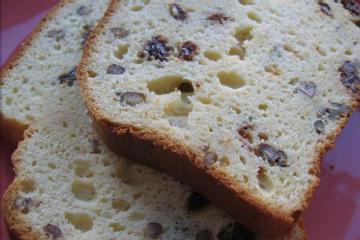
A festive, sweet, and light-colored bread, celebrating the return of the Sun, and the promise of next season’s harvest.
- 4 cups all-purpose, unbleached flour
- 1/2 cup sugar
- 1 tsp. salt
- 3 tbs. butter
- 1 6 oz. packet Sun Maid Sun Ripened Dried Fruit Bits
- Equal amount chopped pecans
- 1 1/2 cup egg nog
- 1 pkg. dry yeast, in 1/2 cup warm water
Warm everything to room temperature. Pitch yeast in warm water, with a pinch of sugar. Mix flour, sugar, and salt; cut in softened butter. Mix in fruit and nuts. When yeast is good and frothy, mix in egg nog and yeast mixture and knead, adding flour as necessary. Let rise about an hour, punch down dough, form into a ball, and let rise again; preheat oven to 350 degrees.
Bake approximately 30-45 minutes until done.
